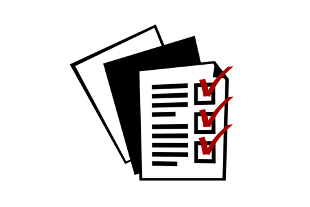Flexible course attendance has become an increasingly desirable option for students seeking more autonomy in how they participate in lecture and learning activities. As more blended and HyFlex courses are offered, students expect more flexibility across the course, specifically in graded activities (Adams et.al, 2021) Evaluative strategies, such as ungrading, have emerged as innovative ways to measure student learning objective mastery (Guberman, 2021; Kohn & Blum, 2020; Pacharn et.al, 2013).
Ungrading can be broadly defined as suspending the traditional way of grading for a more student-centered, empathic, and reflective practice whereby feedback and student reflection replace the assignment of a numerical score or letter grade (Kohn & Blum, 2020). The current grading system in the United States can be traced back to the late 19th century, and since its inception, very little has changed; however, there have always been educators modifying the traditional system, seeking methods of evaluation that were more considerate of the student (Bloom, 1968; Parcharn et.al, 2013). Ungrading can be included in this list of modifications.
The purpose of this article is to provide six steps, or recommendations, to implement an ungrading evaluation system in your courses. These recommendations have arisen from the practice of grading for mastery, educator interaction with the ungrading scheme, and student feedback on learning satisfaction. It is important to understand that the ungrading system presented in this article is heavily focused on deep feedback from the instructor and continual, guided reflection made by the student.

Step 1: Throw out the numerical and letter grades for the students but keep them as a rubric for yourself.
This could likely be a challenge for many students; dropping numerical and letter grades for learners who have only been evaluated through them could elicit a tad bit of stress within the student. Expect this reaction. Also expect that you will have students who will greatly appreciate the unconventional grading scheme. Embrace both of these perceptions and encourage your students to give this scheme an open-minded try.
You will continue to monitor student progress toward goal mastery by using the numerical grading, running parallel to the ungrading scheme. This is your legend that will ensure equity in ungrade and feedback assignment, but your students will not see this legend. Nothing changes regarding how the final grade is reported to your College Registrar, which is why this legend is vital to your course. See Table 1.
Table 1. Grading Legend to Correlate with Ungrading Scheme
| Ungrade | Letter Grade | 7 point scale | 10 point scale |
| Highly Proficient | A | 93-100 | 90-100 |
| Proficient | B | 86-92 | 80-89 |
| Needs Improvement | C | 79-85 | 70-79 |
| Not Proficient | D | 72-78 | 60-69 |
| No Performance | F | <72 | <60 |
Step 2: Commit to providing your students with deeper feedback and on a regular weekly basis
Let’s face it, giving rich, deep feedback takes a lot of instructor time and many of us likely cut this part short, especially if we have a lot of students. Feedback is the cornerstone of the ungrading evaluation process, so short cuts are a big no-no. There are several key components to providing effective feedback with the ungrade that must not be skimped on – specificity, timeframe, revision, and resubmission.
Specificity
Students will never know where improvements are needed without your detailed explanation and a solid, exemplary model of expected performance.
Timeframe
It only takes a few weeks into a semester for students to establish habits from observed patterns expressed by their instructors. Use this fact to maximize your ungrading process by providing the ungrade and associated feedback consistently on the same week day and around the same time. Your students will come to expect this information and feedback on a routine, scheduled basis, and you will be able to balance your work tasks and allocate ample time for feedback.
Revision
Provide students the option of revision. Keep in mind that the is the student’s decision because if they are committed to learning the content, they are more apt to willingly revise the work under your feedback direction, but they should not be required to revise. If the ungrade of Proficient is satisfactory for the student, that is perfectly fine. Regardless, ensure the feedback you provide gives detailed instruction on how to revise the work for improvement.
Resubmission
Direct students to resubmit their revisions before the next weekly feedback day. Revisions should take less time to complete therefore should require less days for resubmission. Along with resubmitted work, consider requiring student reflection on corrections made following your feedback.
Step 3: Clearly explain your ungrading scale to your learners and ensure it is outlined in your syllabus and within your course content.
Certainly you will understand your ungrading scheme, but expect that students will not. To ensure there is no confusion about the manner in which students will receive evaluative information, post your ungrading scale in multiple locations, including clearly outlined in the syllabus and within the online course content. Also include the scheme as part of assignment information and as part of any assessment within your course. This is also known as a rubric.

Step 4: Rubrics are a must and should clearly demonstrate how learners can achieve Highly Proficient in their performance feedback
Including a rubric with any assessment achieves two major purposes: (1) provides learners with a roadmap and detailed list of submission expectations for associated scoring and (2) establishes and equitable system of evaluation. A rubric should be an essential part of any assessment and should maintain the same format and content regardless of application. As with the weekly feedback day, students will establish an expectation of use and understanding when the rubric format maintains consistency. No numerical grades or letter grades should be included in the rubric but rather the ungrading scheme as outlined within the syllabus. Criteria associated with the assessment will obviously differ between assessments, but the ungrading classifications should remain the same. Lastly, the rubric should be used to evaluate the submission and for documentation of feedback. This is the document students will receive for review of evaluation.
Step 5: Plan for regular substantive interaction augmented with broad and narrow feedback, coupled with learner reflection
Regular substantive interaction (RSI) is a requirement for all online courses in postsecondary education; it is included in the Code of Federal Regulations (CFR). It should be understood that your weekly assessment feedback should notice considered as fulfilling RSI requirements; however, it is part of the comprehensive student-instructor interaction within the course.
Two types of feedback to consider providing your students are broad and narrow feedback. Broad feedback comes from comprehensive information that all learners can use to improve and refine their learning. Examples of broad feedback inFAQs, outline of suggested improvements, and supportive resources such as websites and multimedia. Narrow feedback is feedback that is specific to the individual learner. Both of these bring value to your RSI and really serve to demonstrate your commitment to student learning. An example of narrow feedback includes granular, exemplar models of how to make corrections and updates to the specific improvements needed by the student.

Step 6: Plan for student reflection
Preparation is needed to implement ungrading, and these previous five steps will more than adequately prepare you to use this scheme for your formative and summative assessment. Ensure that steps 1 through 5 have been completed and that they will be done with fidelity before beginning this practice. Additionally, consider including the following strategies after implementation.
Student Surveys
Survey your students on their satisfaction with the ungrading model. Make sure your students who do not like the model know they can still use the traditional grading scale because letter grades are aligned to the feedback ungrade.
Personal Reflection
As you utilize the rubrics to complete your ungrading of students through rich, deep feedback, reflect on you personal, an professional, satisfaction with the practice. You may find that this is not the best evaluative model for your students, and if that is the case, it is perfectly fine.
Share with Colleagues
As you implement and utilize this evaluation practice, share your experiences with colleagues. Often some of the best insight and recommendations come from informal discussion between faculty members. Varying perspectives and opinions serve to stimulate ideas for improvement.
Refinement
Do not hesitate to make changes, as needed. Small adjustments during implementation will likely serve to improve students’ interaction with the practice; however, significant changes, such as changing the ungrading terminology, should be made at the end of the semester.
Keep in mind there is no one right way to evaluate student goal mastery, and if you are satisfied with the traditional 100-scale grading system that is perfectly okay. However, if you do venture into the world of ungrading, make sure you have a detailed map and plan when you enter, because if you get confused or become unsure of outcomes, you can rest assured your students are feeling the same. Through systematic and purposeful planning and execution, an effective and efficient ungrading system can promote refined learning in your courses.
References
Adams, S., Bali, M., Eder, Z., Fladd, L., Garrett, K., Garth-McCullough, R., & Weber, N. L. (2021). Caring for Students Playbook: Six Recommendations for Caring for Students. Achieving the Dream.
Bloom, B. S. (1968). Learning for Mastery. Instruction and Curriculum. Regional Education Laboratory for the Carolinas and Virginia, Topical Papers and Reprints, Number 1. Evaluation comment, 1(2), n2.
Kohn, A., & Blum, S. D. (2020). Ungrading: Why Rating Students Undermines Learning (and What to Do Instead). West Virginia University Press.
Guberman, D. (2021). Student perceptions of an online ungraded course. Teaching and Learning Inquiry, 9(1), 86-98.
Pacharn, P., Bay, D., & Felton, S. (2013). The impact of a flexible assessment system on students’ motivation, performance and attitude. Accounting Education, 22(2), 147-167.
Stommel, J. (2022, October 5). Why I Don’t Grade. Retrieved from Jessestommel.com: https://www.jessestommel.com/why-i-dont-grade/
I am so excited to see a conversation about grading. Years ago I read Dr. Robert Marzano’s book about standards-based grading. An example of 4-point: https://marzanoacademies.org/interventions-and-initiatives/reporting-and-grading/. Some authors of gamification for learning are proponents of no grades, Others flip the the learners’ perspective. Instead of earning points from zero, they lose points from 100. If you already have something, you are reluctant to lose any part of it. I have issue with the huge grade hurdle from 0-59 for and F, then 10-points thereafter (60-100). Thank you for the interesting and helpful post.
Thanks for adding this awesome information and link to the resource! Grading is something that stresses most students and, sadly, what they focus on most in a course, We need a mindset shift and to refocus the perspective to learning rather than earning! Great information added! Thanks!